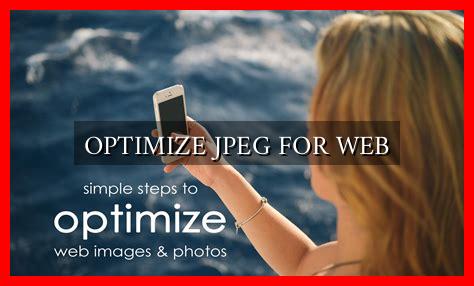-
Table of Contents
- Optimize JPEG for Web: Enhancing Performance and User Experience
- The Importance of Optimizing JPEG Images
- Best Practices for Optimizing JPEG Images
- 1. Choose the Right Compression Level
- 2. Resize Images for Web
- 3. Use Image Optimization Tools
- Case Study: Impact of Image Optimization on Website Performance
- Conclusion
Optimize JPEG for Web: Enhancing Performance and User Experience
When it comes to optimizing images for the web, JPEG is one of the most commonly used formats due to its versatility and compatibility across various platforms. However, simply saving an image as a JPEG file is not enough to ensure optimal performance and user experience.
. In this article, we will explore the importance of optimizing JPEG images for the web and provide valuable insights on how to achieve the best results.
The Importance of Optimizing JPEG Images
Optimizing JPEG images for the web is crucial for several reasons:
- Improved Page Load Speed: Large image files can significantly slow down the loading time of a web page, leading to a poor user experience and lower search engine rankings.
- Bandwidth Efficiency: Optimized JPEG images consume less bandwidth, making it easier for users to access your website, especially on mobile devices with limited data plans.
- Enhanced SEO: Search engines like Google consider page load speed as a ranking factor, so optimizing images can help improve your website’s search engine visibility.
Best Practices for Optimizing JPEG Images
Follow these best practices to optimize JPEG images for the web:
1. Choose the Right Compression Level
When saving a JPEG image, you can adjust the compression level to balance image quality and file size. A higher compression level reduces file size but may result in a loss of image quality. Experiment with different compression levels to find the optimal balance for your images.
2. Resize Images for Web
Before uploading images to your website, resize them to the appropriate dimensions to avoid displaying oversized images that need to be scaled down by the browser. This can help reduce file size and improve page load speed.
3. Use Image Optimization Tools
There are several online tools and plugins available that can automatically optimize JPEG images for the web. Tools like TinyPNG and plugins like WP Smush can help reduce file size without compromising image quality.
Case Study: Impact of Image Optimization on Website Performance
A study conducted by Akamai found that optimizing images for the web can lead to a 40% reduction in page load time, resulting in a 7% increase in conversion rates. This highlights the significant impact that image optimization can have on website performance and user engagement.
Conclusion
Optimizing JPEG images for the web is essential for improving page load speed, bandwidth efficiency, and search engine visibility. By following best practices such as choosing the right compression level, resizing images, and using optimization tools, you can enhance the performance and user experience of your website. Remember, a faster website leads to happier users and better search engine rankings.





